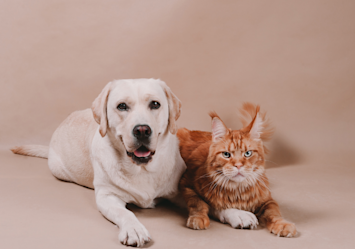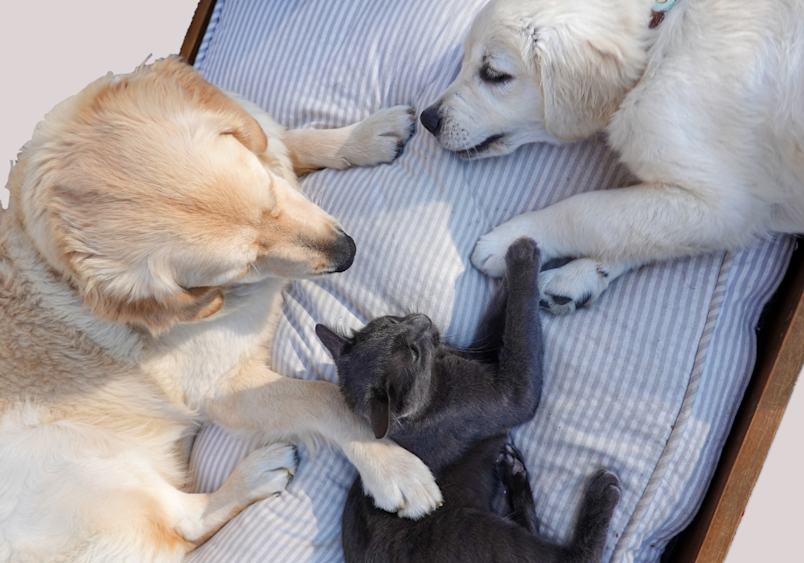
One of the most famous feuds in history is that between cats and dogs. Even more infamous than the dispute between the Capulets and Montagues, the animosity between canines and felines has been causing headaches for pet owners for centuries. Some people wonder, are there any cat breeds that get along with dogs?
While an animal’s personality is never guaranteed, there are indeed many types of cats that are renowned for being easy-going around even the largest of canines. Let us introduce you to the best cat breeds for dogs, so you can give your furry family members the best chance at having a harmonious relationship. (And yes, it’s possible!)
Can Cats and Dogs Really Get Along?
You might have heard that cats and dogs are simply too different to get along. This is absolutely not the case! Many homes include cats and dogs that not only merely tolerate each other but wind up becoming best friends. We’ve all seen viral videos of cats kneading a puppy’s belly or doing something equally cute, and your pets could develop the same friendship!
What makes some animals bond so well? It comes down to a couple of factors. First, many times, these unlikely pairings are due in part to the breeds involved. The friendliest cat breeds often do well with equally mild-mannered dogs such as Golden Retrievers and Basset Hounds.
Similar temperaments aren’t the only factor that eliminates any sibling rivalry among your pets, though. Introducing your pets to each other the right way (and at a young age) can also have a substantial impact on their feelings toward each other. So can making sure your cats have a safe place (preferably high in a cat tree or other climbing structure) to retire to when they’re feeling on-edge around a canine.
Of course, it’s just as important that your dog has their own comfortable space such as a bed in a quiet, calm corner of the home they can rest in if they want to have some time away from a particularly frisky feline.
What Makes the Best Cat Breeds for Dogs?
Cats that get along with dogs often have a number of traits that make them more likely to view a curious dog as a new buddy rather than someone to be feared (or bossed around, as is the case with certain cantankerous kitties!).
The best cat breeds for dogs are all-around friendly and interested in playing instead of fighting. They’re not as aloof or territorial as some breeds and can easily adapt to changes in the home. A new puppy in the home will be a source of curiosity rather than fear or aggression.
Some cat breeds actually enjoy playing with others and are more likely to try and snuggle up with a Saint Bernard than to swat at it!
Breed genetics play a large part in cat personality, and you can get a good idea of a kitten’s future behavior by examining their parents’ behavior, especially the father’s. Early socialization can also play a key role in making a cat more friendly over time, so adopting young pets can increase the chance of tranquility in your household.
Top Cat Breeds That Get Along with Dogs
The breeds discussed below are renowned for making great companions for dogs. While many pet owners can attest that these breeds have proven fantastic fits for their homes, it’s essential to remember that all cats, even ones from the same breed, are unique.
You can get an idea of whether a particular kitten or adult cat is going to do well around your dog by observing their parents or littermates if possible. If you adopt your cat from a shelter or rescue, ask the attendants if the cat has shown any aggression or affection for dogs. They can often get a general idea of a cat’s behavior from watching its interactions in the shelter.
Older cats might be more set in their ways if they haven’t been around dogs in the past. On the other hand, it’s certainly possible that an older cat grew up around a dog and actually loves them! Don’t be afraid to ask for as much background information as possible about your new pet.
In general, what cats are good with dogs? Let’s take a look!
Ragdoll
With a name like “Ragdoll,” you can bet these sweet kitties have a reputation for being the most docile around! They’re nearly universally acclaimed for being not only gentle and affectionate but for having a dog-like personality, too.
When a human picks up a Ragdoll, they go limp in the person’s hand, a clear indication of their willingness to be cuddled and otherwise doted over. This semi-longhaired breed is often cited as acting like one of the dog pack, which will make a doggy sibling much more comfortable. Rather than lurking from towering heights around the home (i.e., the top tier of a cat tree or the shelf above the television), these friendly felines are much more likely to be found snoozing on the floor as if they’re one of the pups.
Maine Coon
The Maine Coon might look intimidating to a small dog, but these large cats have earned the moniker of “Gentle giants” for a good reason. Maine Coons are a vocal breed that has one thing on their minds: socializing. These plush cats want to be friends with anyone, anywhere. In fact, they have no problem marching right up to a Great Dane and demanding attention.
They’re also known for being exceptionally confident, which comes in handy with their interactions around larger dogs. Most Maine Coons will make it known rather quickly that they’re the true rulers of the roost, but they’ll do this with a friendly look or self-assured strut.
Birman
If your dog loves the quiet, a Birman sibling might be just what they need. This medium-sized breed is related to the Siamese cat and shares the same point patterned coat, just in a longer form.
These cats aren’t only beauties – they're charmers, too! They’re not as territorial as some cats, and often welcome dogs into their space. Birmans are more curious than confrontational, a lovely match for canines that want to socialize.
Bombay
A Bombay cat isn’t just distinctive because of its solid black coat and round copper eyes. The breed is beloved because of its gregarious personality, which it owes to its Burmese and American Shorthair heritage.
These cats are highly social and eager to bond with not only the humans in their adopted family but the dogs as well! The typical Bombay loves to play, a trait that makes them ideal siblings for lively dogs.
American Shorthair
Another one of the best cat breeds for dogs is the American Shorthair. Although this cat comes with a strong independent streak, that doesn’t mean they’ll be standoffish with your dog. Instead, their independence bolsters their personality by helping them stay calm and adaptable.
An American Shorthair will likely watch a dog with interest but might keep their distance, occasionally coming out to play. In fact, some American Shorthairs get even more playful as they get older!
Other Sociable Cat Breeds That Are Good with Dogs
To a lesser extent, the Abyssinian, Siberian, and Tonkinese breeds are also worth considering when bringing a new cat into a home with a dog. Pet owners in the U.S. will likely have a harder time finding a Siberian or Tonkinese cat available for adoption or purchase, but Abyssinians have become increasingly common.
These three cat breeds are all very intelligent and like to feel like they’re part of the family, even around dogs!

How to Introduce a Cat to a Dog
Don’t make the mistake of introducing a dog to your cat by simply placing them in the same room together and hoping for the best. First impressions go a long way, and you want to make sure both animals are completely comfortable with the other’s scent before letting them meet face to face.
Even the friendliest cat and dog breeds need to be introduced slowly. Always monitor their initial reactions to keep both fur-babies safe! You’ll want to first keep your new cat confined to just one room in the house with the door shut. Let the cat and dog become familiar with each other’s scent through the door. They’ll slowly get acquainted with each other’s sounds and smells.
Once they’ve relaxed around each other’s scents (which might take a few days), you can let them view each other through a partition like a large sheet of plastic or screen. When they’ve become comfortable with this step, you can move on to cautiously allowing them in the same room.
Brush up on how to read your cat’s body language as well as your dog’s so that you can separate the animals at the first sign of fear or aggression if necessary.
Maintaining a Peaceful Cat-Dog Household
All families experience conflict from time to time. By training both your cat and dog (yes, cats can be trained to an extent!), you can help manage any friction that arises. Teaching your dog basic commands like “Come,” “Leave it,” and “Stay” can help you immediately remove your dog from a negative interaction. Although your cat likely won’t learn as many commands as your dog, you can still use treats and praise to encourage your cat to come to you when called.
Note that a stressed dog is more likely to become aggressive. That means you’ll need to make sure your animals’ physical and emotional needs are met to prevent spats. The saying “an ounce of prevention is worth a pound of cure” is entirely applicable here! Prevent dangerous mishaps by keeping your pets’ food bowls and water bowls away from each other so they don’t feel like they need to compete for resources.
You can also make sure your pets get plenty of exercise, so they don’t have too much pent-up energy and decide to chase each other out of boredom. Additionally, don’t let your cat and dog think you’re picking favorites. Give them equal attention so neither comes to view the other as a threat to your attention.
Why Pet Insurance Helps in Multi-Pet Homes
If you’ve already started crunching the numbers of how much adding a cat to your family will cost, you’ve probably already considered food costs. But have you factored in vet fees to those financial calculations?
Caring for both a cat and a dog can be very expensive when your beloved pets experience health issues. Between annual check-ups and the occasional emergency vet visit, pet owners can spend a lot of money keeping their loved ones safe.
Consider purchasing dog insurance and cat insurance plans to manage your animals’ medical bills. Embrace offers customizable policies and a Wellness Rewards program that can help you budget for routine expenses throughout the year. Fewer vet fees mean more money to spend on toys and treats for your pets!
Cats and Dogs Can Be Friends for Life
The best cat for dogs is one that happily tolerates the occasional sniff from a curious canine and doesn’t shy away from social interactions. Ideally, both animals will be young when meeting for the first time so they will be more tolerant of each other. While it’s impossible to accurately predict a cat’s behavior 100% of the time, there are several cat breeds that are known for being calm and relaxed around dogs.
Don’t get discouraged if your dog and cat don’t take to one another the first day they meet. Bonding takes time, and with a little help from their pet parent, your animals will soon become perfect playmates!